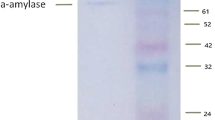Abstract
The effects of pH values, temperature and some elements on the amylolytic activity and stability of the purifiedS. aureofaciens 77 amylase were studied in this investigation. The purified enzyme showed its maximum activity at pH6 within 8 min incubation at 40°C. None of the tested 6 metals showed on stimulatory effect on the enzymatic activity, Fe+++, Cu++ and Hg++ at high dose inhibited the enzyme activity to great extent as compared with Zn++, Mn++ and Fe++ which gave less effect in this respect. The enzyme liquor was found to be thermolabile, since it lost completely its activity after 4 days incubation under room temperature and showed maximunt activity during this period as a result of additions of Ca++ and NaCl. Gradual reduction was however recorded until activity reached 30% after 60 days of incubation.
Similar content being viewed by others
Literature Cited
Samia, A.I.: Production of amylase byStreptomyces. M.Sc. Thesis, Cairo Univ. (1969).
Mosely, M.M. and Keciy, L.: Purification and characterization of the α-amylase ofB. subtilis NRRL. B 34 II,Biotech. Bioeng. 12 251 (1970)
Dawod, M.A. Biochemical studies on amylase and protease activity and stability during production. M.Sc. Thesis. Faculty of Agric., Cairo Univ. (1984).
Omer, N. and Berkhan, B.: Activity ofB. subtilis amylase heated at different temperatures. (1978).
Obi, S.K.C. and Odibo, F.J.C.: Partial purification and characterization of thermostableActinomycete β-amylase.Appl. Environ. Microbiol. 47 (3), 571 (1984).
Abramov, Z.T., Tsaplina, I.A., Mstepanov, V. and Gloginova, L.: Purification and properties of α-amylase fromThermoactinomyces vulgaris strain 42,Biokhimya 51(1), 119 (1986).
Fairbairn, D.A., Priest, F.G. and Stark, J.R.: Extracellular amylase synthesis byS. limosus. Enzyme Microb.Technol. 8(2), 89 (1986).
Arafa, M.A.I.: Microbiological studies on the production of certain enzymes by some strains ofStreptomyces. Ph.D. Thesis, Faculty of Agriculture, Al-Azhar Univ., 1988.
Dawson, R.M. Elliott, D.C. Elliot, W.H. and Jones, K.M.: Data for biochemical research. Oxford at the Clarendon Press Second Edition, p.483 (1969).
Smith, B. and Roe, J.: Colorimetric determination of amylase activity.J. Biol. Chem. 227, 357 (1957).
Caraway, W.T.: A stable starch substrate for the determination of amylase in serum and other body fluids.Am J. Clin. Pathol. 32, 97 (1959).
Okazaki, K., Hata and Komatsu, H.: Digestive drugs. XX-Antiseptics. XXI-β-amylase 1. XXX-β-amylase 2.Yakuzaigaku,20, 23;26; 32, (1960).
Author information
Authors and Affiliations
Rights and permissions
About this article
Cite this article
Ibrahim, A.N., Ibrahim, M.M.K., Ahmed, F.H. et al. Activity and stability of purified amylase produced byStreptomyces aureofaciens 77. Arch. Pharm. Res. 13, 33–37 (1990). https://doi.org/10.1007/BF02857831
Received:
Issue Date:
DOI: https://doi.org/10.1007/BF02857831



